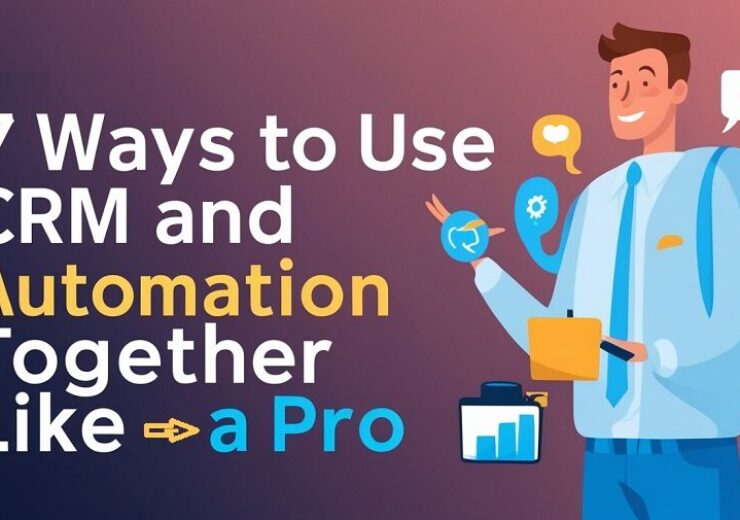7 Ways to Use CRM and Automation Together Like a Pro

In today’s world, which is constantly evolving with technology, holding customer data is no longer sufficient. Businesses are required to take action for this data in a smart and timely manner. Integrating CRM with automation deals with this problem. The combination of these two offers enhanced automation of repetitive tasks, quicker responses, tailor-made interactions, improved accuracy, and greater effectiveness.
The integration of CRM and automation changes the way teams’ function for the better. From capturing leads and sales pipeline management to real time analytics reporting and team functioning, automation does it all.
In this article, we will detail the expertise required in combining CRM and automation to get unbelievable benefits for your business.
Understanding CRM
—————————-
The CRM systems focus on assisting businesses with managing their interactions with current and prospective customers and business partners. CRMs have centralized databases which contain an individual’s contact information, his communication history, available sales opportunities, and even support cases. This makes it simple for marketing, sales, and customer support teams to have all the information they require about a specific customer at their disposal.
Today’s CRMs are much more than a mere electronic filing system that stores information. They offer pipeline management tools, performance tracking tools, and even customer engagement tools which help in closing sales and cultivating relationships. CRM automation tools enable proactive steering of business growth, improve customer satisfaction, and make effective multichannel contact possible.
Automation in CRM
—————————-
Automation in CRM involves utilizing tools to systematically carry out repetitive processes, initiate procedures based on pre-set parameters, and optimize the flow of work. This ranges from sending follow-up emails to changing the status of leads to sending them emails and updating their account to task delegation.
Automation is applicable in several functions of CRM:
- Marketing: Drip campaigns, emails for email marketing, and lead scoring.
- Sales: Reminders for tasks, updating stages in deals automatically, and scheduling meetings.
- Support: Reassigning tickets, triggering escalated response, and surveys for client satisfaction.
CRM workflow automation in itself reduces manual work and improves uniformity, which helps teams concentrate on strategic work such as relationships and closing deals.
Benefits of Integrating CRM Automation
- Time Saving: Chatting and emailing reduces effective working hours, automating reminders and account updates enables data entry to become instant.
- Improving Accuracy: Automation leads to near zero human error pertaining to leaving leads unmanageable within the system and going unnoticed.
- Enhancing Customer Experience: No chance is lost due to Automation features tracking and closing any gaps that exist by providing timely and personalized interactions.
- Providing Real-Time Insights: Reporting, tracking, and monitoring the progress allow users to receive up to date information with the push of a button.
- Enhancing Scalability: Growth alongside business demand enables businesses to respond to changes easily.
7 Tips for Using CRM with Automation Like a Pro
—————————-
1. Automated Lead Capture and Assignment
Without automation, capturing leads from several sources such as web forms, email, social media, and even live chats can quickly become tedious. In a connected world where businesses operate via multiple channels, leads can now be directly fed into the CRM database along with all pertinent information.
After capturing the leads, the next step is assignment according to preset rules such as geographic area, interest in specific products, or sales workload for each representative. Not only does this allow quicker reaction times, but it also mitigates the risks of leads getting lost. Representatives can also be prioritized in engagements due to automation of scoring leads through interactions.
2. Streamline Sales Pipelines Using Automated Workflows
Touchpoints within sales pipelines start from initial contact and dive deep into closing the deal, which, for most businesses, is a multifaceted process that has several steps. With automated sales processes, there are workflows created to take actions that correspond to movements made in the pipeline automatically.
Take, for example, sending a proposal to a client. Once a proposal has been sent and a negotiation phase is underway, sales reps should be able to follow up, and automating these tasks should free up time within the sales teams. Stuck deals might mean that certain managers get notified. From all ends, ignored or neglected tasks that everyone hates should get tackled, and pipelines should never have unused completions, aiding them to flow smoother than before.
3. Personalize Customer Communication
Messages tailored for individual customers always resonate better for businesses and their customers. Automating your CRM lets you send messages based on customer behavior, preferences, and their purchase history.
Send automated birthday wishes, follow-up messages, or special deals according to previous purchases. If a customer opens a URL within a product email, a follow-up email can be sent automatically through the CRM, or a sales representative can be alerted to make the outreach.
Customers receive automated engagement messages which makes them feel more appreciated, and in return, attending to their needs makes them more engaged with the services provided. It is proven that personalization with the help of CRM data increases engagement rates and improves customer satisfaction.
4. Automate Customer Onboarding
Customer onboarding automation A smooth onboarding experience paves the way to an enduring customer relationship. Sending welcome emails, product guides, and tutorial videos at set times makes onboarding effortless.
Also, you can automatically allocate internal responsibilities, like scheduling kickoff calls and creating user accounts for the appropriate staff. This allows all customers to receive the same professional and polished onboarding experience from day one while alleviating the work burden on their team.
5. Using Auto-Ticketing and Routing for Enhanced Customer Support
Automation allows support staff to convert a customer’s email, chat, or contact form submission into a support ticket instantly. The CRM can prioritize routing to the appropriate team or agent by issue type, urgency, or customer tier.
With this system, you can also automate notifications to update customers regarding ticket resolution status, satisfaction surveys post-resolution, and escalation of overdue tickets. All these result in significant improvement to resolution speed and customer service experience.
6. Schedule Reports and Insights Automatically
Data is essential, but pulling together reports can be a painstakingly tedious manual process. With automation in CRM systems, sales performance, lead sources, or campaign effectiveness can be set to reporting periods daily, weekly, or monthly and compiled automatically.
With automated dashboards, stakeholders will have access to current insights in real time, while reports will be sent via email, ensuring the workforce operates as a cohesive unit and is making decisions from relevant and freshly dated information.
7. Drip Campaigns for Lead Automation
Each customer has a unique shelf life; nurturing them through the right content serves to deepen their interest, moving them closer to a potential ‘purchase’. A drip campaign is one approach that is supported by CRM automation, and entails sending emails at set intervals after an initial action is taken.
For example, if someone downloads a whitepaper, you can automatically enroll them in a related educational series. Depending on a potential client’s interaction level, the CRM system can either change their engagement status or alert the sales department when they are ready to be converted.
With this method, your leads begin to trust your brand with their most unwavering belief, as the touchpoints are built.
Final Thoughts
CRM and automation each offer value on their own, but together, the efficiency of double dynamo is untamed. Whether it is capturing leads or nurturing relationships, while restreaming the sales funnel and support services, engagement automation aids literally every single step in the consumer journey. Your brand stands to gain a lot in automating customer relationship management; from creating brand loyalty based on consistent personalized services, to time-saving and increased productivity.




